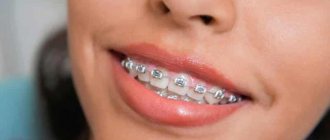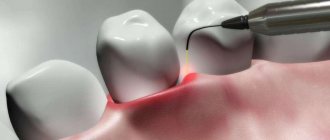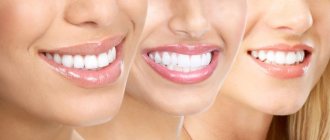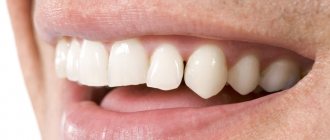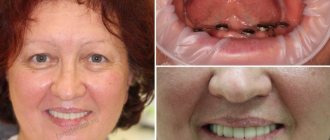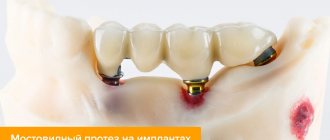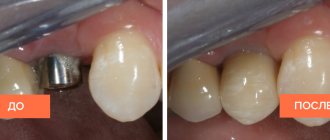- 15801
- 09-10-2020
- Author: Mysekret Team
- 0
Dreams of a Hollywood smile, perfect straight and white teeth without the intervention of dentists and exhausting procedures have become a reality. Perfect Smile Veneers is an innovative development that allows you to realize these desires at home without the use of dental onlays.
In what cases are veneers placed, and who can do it?
Microprosthetic surgery is suitable for people over 18-20 – those whose teeth are already fully formed.
Accordingly, it is better for children and adolescents to wait. To undergo the procedure, a person must be healthy. Caries and other oral diseases must first be cured.
A suitable surface for fixing the pads is also important. If the incisor has been torn out, an implant is first placed in its place and a plate is fixed on it.
Pros and cons of veneers
Their advantages are as follows:
- They give results immediately - a snow-white smile will appear either in 1 visit or in 1-2 weeks. They do not need to be worn for years (like braces) to see visual improvements.
- They serve for quite a long time - from 5 to 20 years or even more.
- They look natural – indistinguishable from natural incisors and premolars.
- Easy to clean - you can use the same brush and paste as before.
- Inexpensive - much cheaper in price than other aesthetic solutions.
But there are also disadvantages, and these are:
- Impossibility of repair - if a chip, crack or other damage occurs, the lining will have to be replaced.
- The operation is irreversible - it is accompanied by the removal of enamel, so in the future it will no longer be possible to walk without a plate.
- Changes in eating habits - with such microprostheses, you can no longer eat solid foods (for example, nuts) or drink drinks that have a coloring effect.
How can digital technology help transform your appearance?
Our clinic actively uses Digital Smile Design technology (“digital smile design” or DSD, read as “digital smile design”) in combination with the principles of Dental Face Lifting (“dental facelift”). Based on the capabilities of digital computer modeling, we restore the ratio of the proportions of the face and teeth according to the “golden ratio” principle using orthopedic and orthodontic structures (for restoring teeth with the help of dentures, as well as correcting the bite, respectively).
We recreate the correct anatomy of the teeth, normalize the chewing load, restore youth to the facial contour and get exactly the smile that suits the patient best.
Every person is unique. Therefore, there are no template solutions. The patient’s personal information is loaded into the Digital Smile Design program - his photographs, computed tomography and intraoral scan data. Based on them, the doctor creates a model of the future smile, taking into account all individual anatomical features. And then the models are transferred to the articulator in order to verify the bite relationships and make adjustments if necessary.
Digitally designed veneers transform your smile and look more natural
All the necessary proportions and measurements are included inside the program. She suggests how best to work out the aesthetics and draws up a step-by-step treatment plan.
Making veneers is a multi-stage and expensive procedure; the cost of an error is quite high. Therefore, it is useful for all participants in the process - the patient, the orthopedic surgeon and the dental laboratory specialists - to have the same information, which cannot be interpreted in their own way. It is this consistency that careful planning of the treatment process can achieve.
The DSD program transmits clear data backed up by 3D images to the laboratory. Everything is taken into account: the shape, shade, height and width of future restorations, their exact positioning and relationship with the gum. Distances are adjusted to fractions of a millimeter, and the color of future veneers is selected on a scale taking into account the color of the patient’s eyes and skin.
This means that the risks of the human factor are eliminated. There will be no errors in color perception or distortions in shape. The laboratory, the orthopedic dentist and, of course, the patient will not differ in their expectations of the result.
Ceramic veneers
natural look requires turning Price: from 25,000 rub. Price: from 25,000 rub.
Zirconium veneers
stronger and thinner turning is required Price: from RUB 25,000. Price: from 25,000 rub.
Ceramic composite
light and durable turning is not always required Price: from 15,000 rubles. Price: from 15,000 rub.
Lumineers
the thinnest veneers do not require turning Price: from 65,000 rubles. Price: from 65,000 rub.
We create beautiful smiles! Veneers and lumineers are non-staining and protect teeth. 3D modeling is included in the price!
Free consultation
Indications and contraindications
Your doctor may recommend this option if:
- the top and/or bottom row is uneven;
- the enamel has darkened and/or cracked;
- irregularly shaped incisors;
- There are gaps between the teeth.
But the defects should still be minor.
The orthodontist will have to refuse the procedure if:
- most of the problem surface is sealed and/or destroyed;
- there is an incorrect bite;
- there is abrasion (starting from the second degree);
- have gum disease;
- the patient suffers from bruxism.
Each situation is considered individually.
Where else is digital smile design used?
Smile planning using digital technology is suitable for everyone who wants to have a harmonious face that is as close as possible to the canons of beauty. There are no contraindications or age restrictions. Therefore, the technology can be used wherever an accurate plan and predictable aesthetic effect of treatment is needed: implantation and prosthetics, the creation of various orthopedic structures, surgical gum surgery and even orthodontic treatment.
In what cases will computer planning procedures help?
- slight disproportion and asymmetry of the face,
- abrasion of enamel and decrease in bite height,
- violations of aesthetics - chips, dark spots, uneven teeth,
- absence of one, part or all teeth,
- age-related changes, wrinkles in the lip area, deepening of nasolabial folds,
- loss of facial muscle tone, drooping soft tissue in the lower third of the face,
- sinking of the cheeks and corners of the lips,
- desire to change the shape and color of teeth.
Digital modeling greatly improves mutual understanding between the prosthodontist, dental technician and patient. As a result, the patient gets exactly the smile he dreamed of.
What you need to know before installation
You've already read how dental veneers are made step by step, and you've also looked at photos of finished smiles. Are you making up your mind? Please note the following points:
- The operation is completely safe if the preparatory procedures are carried out correctly.
- There is no upper age limit.
- Grinding is mandatory - some layer of the natural coating will definitely be removed, from 0.5 to 0.7 mm.
- The condition of the cutter under the plate does not deteriorate (if it is tightly fitted).
- The pad is not removable, but it can be chipped and any damage requires replacement.
- Microprostheses last the longest if you maintain oral hygiene and give up bad habits.
- Biting food after they have been secured should be done carefully; it is better to avoid gnawing hard objects.
Is there any way to install without damaging the enamel?
Not yet, and don’t believe those who promise otherwise. But don’t be upset, turning is necessary and in some ways even useful, because it prevents the plates from layering, clinging to each other, making the jaw heavier, and inflaming the gums.
Features of the glue used
It is applied to the inside of the lining. To ensure better adhesion, the surface of the cutter is degreased and also covered with an etching gel for 3 minutes, but to protect it from bacteria. At the end of this time, the area of exposure is dried and illuminated with a lamp. Excess materials are then removed and transition areas are polished.
Instructions for use
In addition to the installation instructions, it is necessary to take into account the manufacturer's instructions for using the Perfect Smile Veneers design. It is important to store the product correctly and promptly clean it from food residues.
Basic rules when using Perfect Smile Veneers:
- The pads must be stored in a special container included with the product;
- The plates should be washed regularly for cleaning and disinfection;
- It is better to soften the veneers and give them shape immediately before installation;
- It is not recommended to attempt to use the pads for purposes other than their intended purpose;
- The plates must not be broken, bent or subjected to other traumatic effects.
When used correctly, Perfect Smile Veneers can last for many years and will not require immediate replacement.
You can wear veneers throughout the day, but at night it is recommended to remove them and wash them.
The product should be washed according to the manufacturer's instructions:
- Perfect Smile Veneers can only be washed in warm water;
- It is not recommended to use soap substances intended for hair and body;
- You should not use devices with solid particles, for example, scrubs, toothbrushes, especially with hard bristles;
- Avoid using chemicals;
- It is better to rinse the plates under running water;
- The product should dry naturally.
The best way to clean veneers is to use warm water and baking soda; you can also use toothpaste or powder, but apply them with your finger. After the procedure, the plates should be lightly blotted with a towel and left to dry in a well-ventilated area.
Lumineers: indications and installation
They are ultra-thin, they are chosen for the most minor damage:
- chips that do not affect bone tissue;
- fluorosis, darkening, spots, yellowness;
- staining of fillings;
- thinning of the coating, erosion;
- gaps between the incisors, their underdevelopment.
Their price is slightly more expensive than regular records, because they are made using more complex technology. But they hardly need modification (only in 1.5% of situations). It is enough to prepare a 3D model, make 0.5 mm thick overlays on it and place them on glue, after etching the enamel. The procedure is not painful - so much so that, as a rule, it does not require anesthesia.
Benefits of Perfect Smile Veneers
Perfect Smile veneers stand out among their counterparts and other analogues due to their affordable price, versatility and the absence of allergic substances in the composition. They also do not require the participation of dentists during installation.
Perfect Smile Veneers are the easiest and fastest way to sculpt your smile compared to ceramic, porcelain and composite veneers.
The benefits of using veneers include:
- Convenient to put on and take off;
- Durability and durability;
- Possibility to install yourself;
- No cracks or chips after repeated use;
- Masking of the entire row of teeth;
- Do not require preliminary grinding of teeth;
- No adverse reactions or harm to enamel;
- Reliable fixation of plates;
- The pads are ultra-thin and do not interfere with eating or talking.
Among other things, a significant advantage of Perfect Smile is its protective function. Veneers can be used as a special barrier for teeth that are sensitive to hot and cold foods.
Features of fixing microprostheses from different materials
When discussing how you can correctly place veneers on your teeth at the dentist, you need to take into account that the fixation depends on their type.
- Ceramic should be formed in layers, processing after each pass; at the end - firing to acquire strength.
- Zirconium must be turned on an ultra-precision milling machine according to a cast and only in laboratory conditions.
- Porcelain ones need to be made according to a 3D model, very carefully, taking into account the fragility of a single plate.
All these nuances should be discussed with the doctor at the stage of the initial examination, even before the treatment plan is approved, in order to choose the truly optimal type and material of the overlays.
Read also
How to close a gap between your front teeth
When thinking about how to remove a gap between teeth, it is important to learn as much as possible about this defect and how to eliminate it.
How long do you wear braces and what affects the timing?
When deciding on the use of orthodontic structures, patients are often interested in how long they wear braces on their teeth.
Pain after grinding, eating habits
You can watch how veneers are chosen and how they are installed, but the video still won’t tell you about the feeling of discomfort that arises between preparation and fixation of the plates on a permanent basis.
The patient should be prepared that the incisors under the temporary onlays will ache within 4-5 days. During this period, it is better not to eat or drink anything cold or hot, and even rinsing with warm water is recommended. If it gets really tight, it’s acceptable to take a painkiller, but this is usually rare.
But severe and unremitting pain is not the norm at all, but a sign that the operation was carried out with errors, and a reason to immediately contact an orthodontist.
How to care for microprostheses
- Clean the oral cavity more thoroughly - without changing the toothpaste (if it does not contain abrasive particles), but three times a day and with a soft brush, as well as floss and irrigator - immediately after meals. Plus, go to the clinic every 3 months for polishing.
- Adjust your diet - be attentive to coloring foods (berries, beets, tea, coffee, wine), do not bite with incisors protected by plates, and chew with molars.
- Stop smoking so that the linings do not turn yellow and the gums do not become inflamed.


